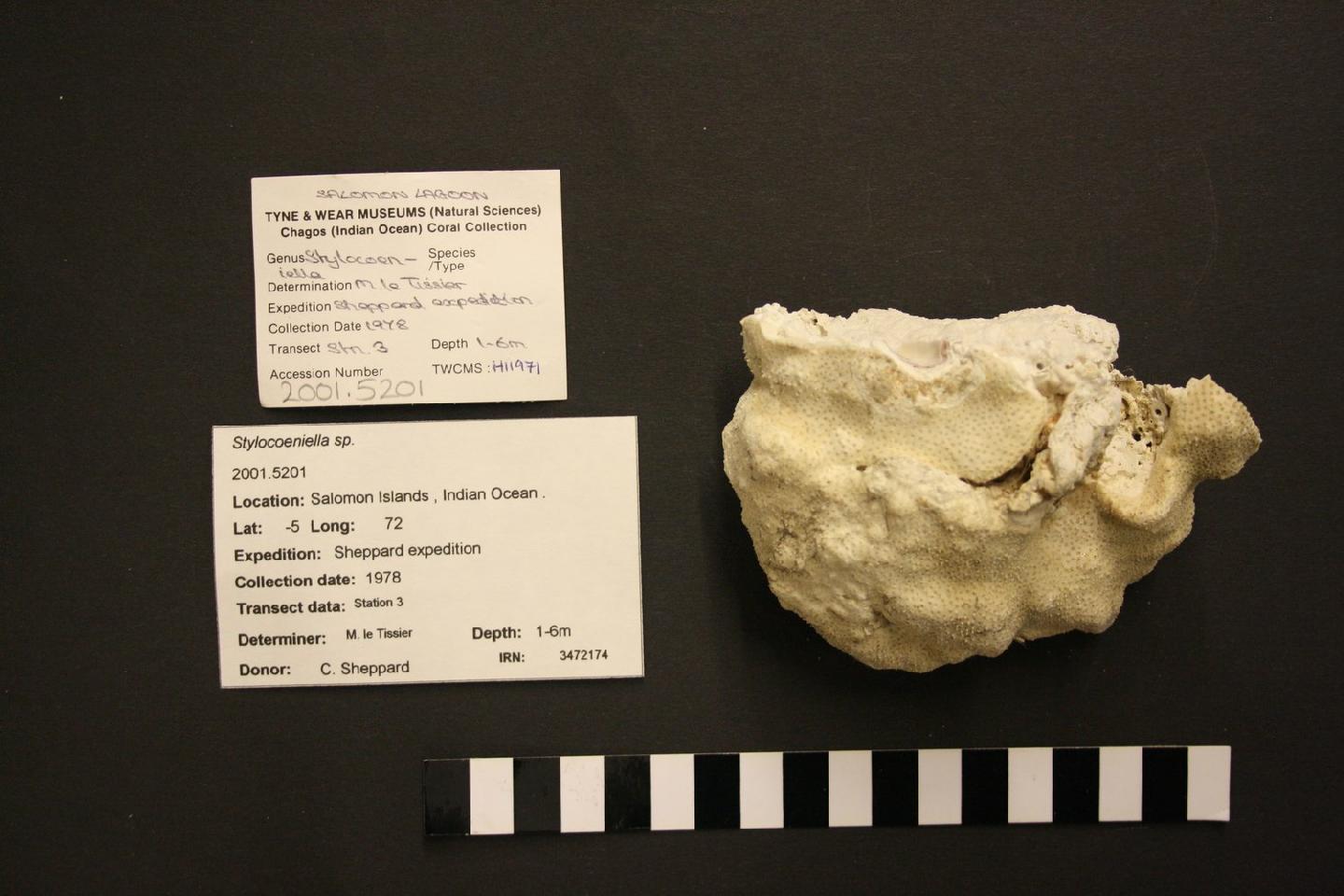WoRMS taxon details
Stylocoeniella Yabe & Sugiyama, 1935
204053 (urn:lsid:marinespecies.org:taxname:204053)
accepted
Genus
Stylocoenia hanzawai Yabe & Sugiyama, 1933 accepted as Stylocoeniella armata (Ehrenberg, 1834) (type by original designation)
Stylocoenia Yabe & Sugiyama, 1932 · unaccepted > junior subjective synonym (homonym)
- Species Stylocoeniella armata (Ehrenberg, 1834)
- Species Stylocoeniella cocosensis Veron, 1990
- Species Stylocoeniella guentheri (Bassett-Smith, 1890)
- Species Stylocoeniella japonica (Yabe & Sugiyama, 1932)
- Species Stylocoeniella nikei Benzoni & Pichon, 2004
- Species Stylocoeniella hanzawai (Yabe & Sugiyama, 1933) accepted as Stylocoeniella armata (Ehrenberg, 1834) (unaccepted > junior subjective synonym)
- Species Stylocoeniella muscosus Claereboudt, 2006 (unaccepted > nomen nudum)
- Species Stylocoeniella paumotensis Chevalier, 1975 accepted as Pavona clavus (Dana, 1846) (unaccepted > junior subjective synonym)
marine, fresh, terrestrial
Yabe H, Sugiyama T (1935) Stylocoeniella, a new coral genus allied to to Stylocoenia and Astrocoenia. Japanese Journal of Geology and Geography 12: 103-105, pl. 15. [details]
Description Colonies are massive, columnar or encrusting. Corallites are immersed, circular, with two unequal cycles of septa and a...
Description Colonies are massive, columnar or encrusting. Corallites are immersed, circular, with two unequal cycles of septa and a style-like columella. The coenosteum is covered with fine spinules and also by larger pointed styles which are almost as numerous as the corallites. Polyps have not been observed extended. (Veron, 1986 <57>)
Encrusting, with small corallites. Associated with each corallite is a small styliform pillar of coenosteum which can be distinguished underwater as well as in cleaned specimens. Two species exist in the Indian Ocean, distinguished by whether the two cycles of septa are unequal (S. guentheri) or equal in size (S. armata). <308> [details]
Encrusting, with small corallites. Associated with each corallite is a small styliform pillar of coenosteum which can be distinguished underwater as well as in cleaned specimens. Two species exist in the Indian Ocean, distinguished by whether the two cycles of septa are unequal (S. guentheri) or equal in size (S. armata). <308> [details]
Hoeksema, B. W.; Cairns, S. (2025). World List of Scleractinia. Stylocoeniella Yabe & Sugiyama, 1935. Accessed through: World Register of Marine Species at: https://www.marinespecies.org/aphia.php?p=taxdetails&id=204053 on 2025-04-04
Date
action
by
![]() The webpage text is licensed under a Creative Commons
Attribution 4.0 License
The webpage text is licensed under a Creative Commons
Attribution 4.0 License
Nomenclature
original description
Yabe H, Sugiyama T (1935) Stylocoeniella, a new coral genus allied to to Stylocoenia and Astrocoenia. Japanese Journal of Geology and Geography 12: 103-105, pl. 15. [details]
original description (of Stylocoenia Yabe & Sugiyama, 1932) Yabe H, Sugiyama T. (1932). A living species of Stylocoenia recently found in Japan. <em>Japanese Journal of Geology and Geography.</em> 9 (3-4): 153-154, pl. 15. [details]
basis of record Veron JEN. (1986). Corals of Australia and the Indo-Pacific. <em>Angus & Robertson Publishers.</em> [details]
original description (of Stylocoenia Yabe & Sugiyama, 1932) Yabe H, Sugiyama T. (1932). A living species of Stylocoenia recently found in Japan. <em>Japanese Journal of Geology and Geography.</em> 9 (3-4): 153-154, pl. 15. [details]
basis of record Veron JEN. (1986). Corals of Australia and the Indo-Pacific. <em>Angus & Robertson Publishers.</em> [details]
Other
context source (Hexacorallia)
Fautin, Daphne G. (2013). Hexacorallians of the World. (look up in IMIS) [details]
additional source Veron JEN, Pichon M. (1976). Scleractinia of Eastern Australia. Part I. Families Thamnasteriidae, Astroceoniidae, Pocilloporidae. <em>Australian Institute of Marine Science Monograph Series.</em> 1: 1-86. [details]
additional source Veron JEN. (2000). Corals of the World. Vol. 1–3. <em>Australian Institute of Marine Science and CRR, Queensland, Australia.</em> [details]
additional source Yabe H, Sugiyama T. (1935). Revised list of the reef-corals from the Japanese seas and of the fossil reef corals of the raised reefs and the Ryukyu limestone of Japan. <em>Journal of the Geological Society of Japan.</em> 42: 379-403. [details]
additional source Smith FGW. (1954). Gulf of Mexico Madreporaria. <em>Fisheries Bulletin of the Fish and Wildlife Service (U.S.).</em> 55, 291-295.
page(s): 294 [details]
additional source Dunn, D. F. (1982). Cnidaria. McGraw-Hill Book Company. New York and other cities., volume 1, pp. 669-706
page(s): 701 [details]
additional source Veron JEN, Pichon M. (1976). Scleractinia of Eastern Australia. Part I. Families Thamnasteriidae, Astroceoniidae, Pocilloporidae. <em>Australian Institute of Marine Science Monograph Series.</em> 1: 1-86. [details]
additional source Veron JEN. (2000). Corals of the World. Vol. 1–3. <em>Australian Institute of Marine Science and CRR, Queensland, Australia.</em> [details]
additional source Yabe H, Sugiyama T. (1935). Revised list of the reef-corals from the Japanese seas and of the fossil reef corals of the raised reefs and the Ryukyu limestone of Japan. <em>Journal of the Geological Society of Japan.</em> 42: 379-403. [details]
additional source Smith FGW. (1954). Gulf of Mexico Madreporaria. <em>Fisheries Bulletin of the Fish and Wildlife Service (U.S.).</em> 55, 291-295.
page(s): 294 [details]
additional source Dunn, D. F. (1982). Cnidaria. McGraw-Hill Book Company. New York and other cities., volume 1, pp. 669-706
page(s): 701 [details]
 Present
Present  Inaccurate
Inaccurate  Introduced: alien
Introduced: alien  Containing type locality
Containing type locality
Unreviewed
Description Colonies are massive, columnar or encrusting. Corallites are immersed, circular, with two unequal cycles of septa and a style-like columella. The coenosteum is covered with fine spinules and also by larger pointed styles which are almost as numerous as the corallites. Polyps have not been observed extended. (Veron, 1986 <57>)Encrusting, with small corallites. Associated with each corallite is a small styliform pillar of coenosteum which can be distinguished underwater as well as in cleaned specimens. Two species exist in the Indian Ocean, distinguished by whether the two cycles of septa are unequal (S. guentheri) or equal in size (S. armata). <308> [details]
Remark Type species: Porites armata Ehrenberg, 1834 (Veron, 1986). [details]

